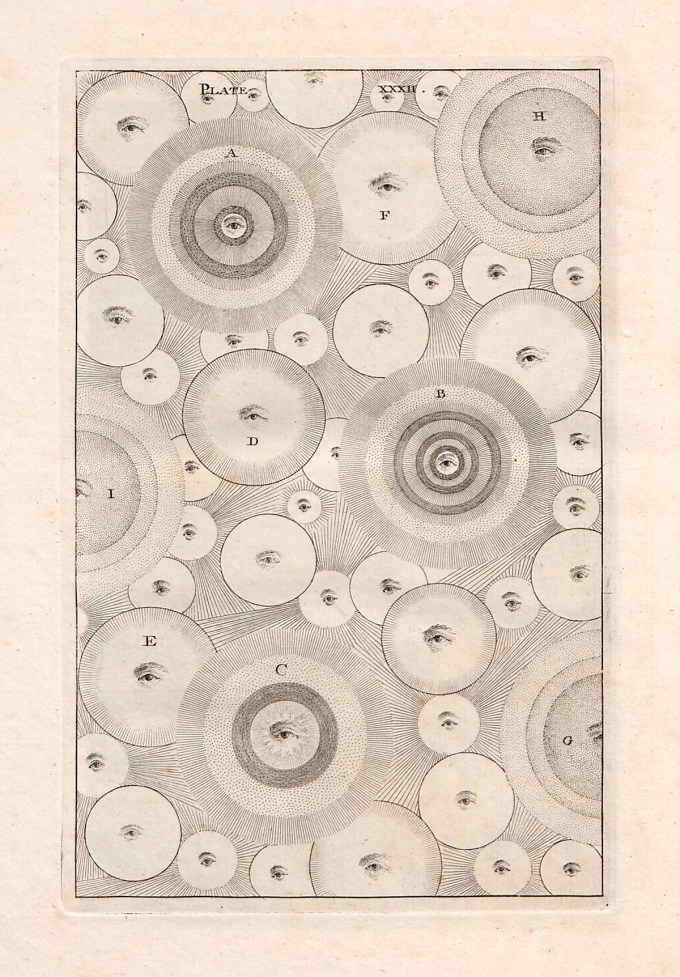In 1750, Wright self-published his visionary and verbosely titled book An Original Theory or New Hypothesis of the Universe, Founded upon the Laws of Nature, and Solving by Mathematical Principles the General Phaenomena of the Visible Creation, and Particularly the Via Lactea (public domain). With his keen aesthetic sensibility — he was also an architect and garden designer — he commissioned “the best masters” to illustrate his theories in thirty-some scrumptious plates populated by comets, planets, and other celestial splendors observed and conjectured.


This might at first sound like a strikingly modern and reasonable argument, evocative of Carl Sagan’s poetic insistence that “the universe will always be much richer than our ability to understand it.” But Wright’s rationale is theological rather than scientific, rooted not in the biological limits of human consciousness or the technological limits of our computational capacity but in the empirically untested and untestable blind belief in the existence of an omnipotent god:

From certain observations only, we ought to form all our notions of [the universe], if we either hope to arrive at truth, or expect our ideas should be supported by reason.
In Astronomy… every man’s reason, by the help of a very little mathematics, is able to bring wonderful truths to light without them; and truths not only of the highest importance to every individual, but of a great and common consequence to all mankind… Time and observation will undoubtedly, at last, discover every thing to us necessary to our natures, and proper for us to know. As a proof of which, we see human wisdom daily increases.

One of the chief and most unquestioned blind spots of this creationist mythology was the absolute faith in the infinity of time and space — a necessary framework to sustain the era’s unquestioned belief in personal immortality: If the soul were to go on forever, it necessitates a spacetime canvas of foreverness to go into. Although we now know that “no infinity has ever been observed in nature” and therefore the universe is by all probability finite, the notion of such finitude was offensive and intolerable to even the most visionary minds of Wright’s era, including his own.

In his book, Wright also makes an exquisitely elegant argument for the existence of other planets orbiting other stars — a notion advanced by Pythagoras millennia earlier but still radical in Wright’s day, now proven four thousand times over by the pioneering NASA mission named for Kepler alone, with more such exoplanets constantly discovered by astronomers around the world. He serenades the beauty of deduction:
It is a humbling reminder that every visionary of every era is still blinded by what they take as givens, and doubly humbling to realize that the same holds for each one of us along the miniature vistas of our everyday lives. And yet Wright was able to live beautifully within his own paradox, insisting again and again that astronomy is a supreme ally to reason and an impartial clarifying force for elemental truth — it allows us to see for ourselves what is true, to glimpse reality on its own terms, unmediated by ideological interpretation:



Bafflingly, the book was republished without the crucial and consummate illustrations — perhaps out of parsimony (this was the Panic of 1837, America’s first great economic depression), and perhaps in a clever marketing tactic, for the publisher’s introduction teased with the promise of a forthcoming separate folio containing only the illustrations. No record of such a publication survives, but I have restored these antique beauties from Wright’s original 1750 edition and made them available as prints and wearable artworks, benefiting the endeavor to build New York City’s first public observatory.
Only 118 copies of the book were printed, all for Wright’s patrons and private subscribers. (A delight to think that a long-ago astronomer sustained his work the way I do.) One eventually reached Immanuel Kant, who was especially captivated by Wright’s explanation of why the Milky Way appears to us the way it does — an optical effect owing to our particular position within the plane of the galaxy — and by the notion of multiple galaxies. Kant seized upon these ideas and developed them in a book he published anonymously five years later, drawing on Wright’s theories to conceive of his famous “island universes,” which went on to influence generations of astronomers all the way through Hubble and his epoch-making observational proof.
Suspended halfway between the time of Kepler, who discovered his revolutionary laws of planetary motion while defending his mother in a witchcraft trial, and the time of Hubble — halfway between the age of superstition and the age of science — Wright, for all his visionary genius, was still trapped in the ideological monoculture of his time — a time that conceived of science as a handmaiden to theology, tasked not with discovering truth but with proving the perfection of a creator-god held as a postulate.
As Kant’s authorship was discovered, his celebrity subsumed these theories, which came to be attributed to him. Wright and his book fell into obscurity, until a polymathic French scientist married to an American woman and living in Philadelphia rediscovered it nearly a century later and published it at his own expense. He dedicated the book to “the American people,” feeling that they were in dire need of a reminder that “knowledge is power” and that “in our republic, as power is confided to the care of the people, it is necessary that they should be correctly informed of vital points, so that they may avoid vital errors.”

Thomas Wright (September 22, 1711–February 25, 1786) grew up with a passion for learning and a speech impediment that made the rural English schoolroom a gauntlet. When he set about educating himself at home, his father declared the boy mad for his mathematical passions and burned all the books his mother had bought him. Undeterred, Thomas found a mathematics tutor in a local astronomer, took free science classes at a local parish, then apprenticed himself to a London instrument-maker, falling deeper and deeper in love with astronomy and the quest for elemental truth. By nineteen, he had established a school of his own to teach mathematics and navigation. He would go on to build an observatory, describe the spiral shape of the Milky Way for the first time, declare himself “an enemy to the taking of any thing for granted, merely because a person of reputed judgment has been heard to say it absolutely is so,” and become the first person to suggest that there are galaxies other than our own, nearly two centuries before Hubble staggered our understanding of the universe with the empirical proof.
Complement with the astronomical art of Maria Clara Eimmart — who schooled herself to be an artist and astronomer a century before Wright, in an era when women had no access to formal education in either art or science — and the stunning celestial beadwork of Native artist Margaret Nazon, then savor this wildly original tapestry of thought about infinity, art, science, and the meaning of freedom by mathematician Lillian Lieber, who won Einstein’s ardent admiration.


All the attributes of the Divine Being are, as any one of them, incomprehensible to his creatures; why should our imagination then be supposed to extend beyond the divine activity?
After quoting Milton (whose Paradise Lost features the first English use of the word space in the astronomical sense), Wright adds:

To say that the Stars, which are a certain visible sort of contemporaries in space with the Sun, have no like planetary bodies like ours moving round them, because we cannot possibly see them, is no less absurd and ridiculous, than to argue, that we can have no reason to expect to find in the proper season, grapes upon every vine — figs upon every tree — roses upon every bush — only because some of them are at such a distance, that neither rose, fig or
grape, can be discovered by the eye.
Wright inveighed against the notion of finitude with passion:
Creation must be not only extensively, but intensively indefinite, and beyond the reach of the human understanding to comprehend… The one is as necessary as the other, i, e, an infinite expanse is as reconcileable to our reason, as infinite parts are to our senses.



